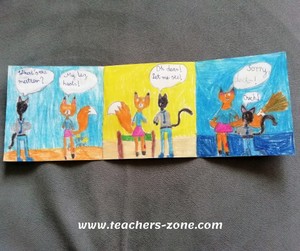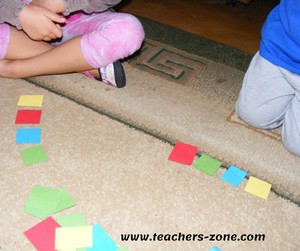Drawings
Students draw pictures illustrating new words in English or collect thematically connected items around one picture. It can be a seedbed to label the items on the picture, make sentences with new English vocabulary, describe what is going on the illustration or discuss more abstract issues with your ESL kids.
Mind maps
Mind maps help ESL kids to organize their vocabulary around a single topic. Creating a mind map is an ideal opportunity for your students to put all English words and phrases they know together. It is useful especially preparing for discussion on a specific subject.
Comics

Sequence of pictures is drawn and then some texts are added in the bubbles. This technique is a great way to put phrases that are taught in the meaningful context created by students themselves. These dialogues from the comics can be practiced in pairs or small groups.
Calligrams
Students create pictures by the words which illustrate their meaning. New English vocabulary or phrases are written in such a way that expresses what they say and helps to learn them by heart. This technique matches greatly learning of a foreign language and ESL kids’ art creativity.
Associations
A new word in English can be associated with another one thematically connected, with its function or with some places. Associations between words and expression can be different even absurd, but each one is good if it makes remembering new English vocabulary easier.
Games and play

The best way for ESL kids to learn new English vocabulary are games and play. These are the most natural and the funniest activities for children. They have learnt their mother tongue this way and that is why they should learn a foreign language in the same way.
Read more about play and games in the primary classroom.
ESL kids should experience as many as possible oportunities to listen and repeat a foreign language they have learnt. Repeating new English vocabulary and phrases after a teacher or a recording should be introduced gradually - at first in chorus and then the number of the repeating learners should be reduced to individual repetitions.
Songs, rhymes and stories
Songs, rhymes and stories which are attuned perfectly to ESL kids needs can be effective teaching strategy. They not only help children remember English vocabulary and structures, but also practice listening and speaking skills. Besides, these teaching techniques help with creating friendly and motivating atmosphere to learn, as children love singing and listening to stories.
ESL kids should be taught that see or hear a new English word once is not enough to remember and use it properly. The role of a teacher is to organize English lessons so that ESL kids could practise new English vocabulary in many different ways and situations.
Немає коментарів:
Дописати коментар